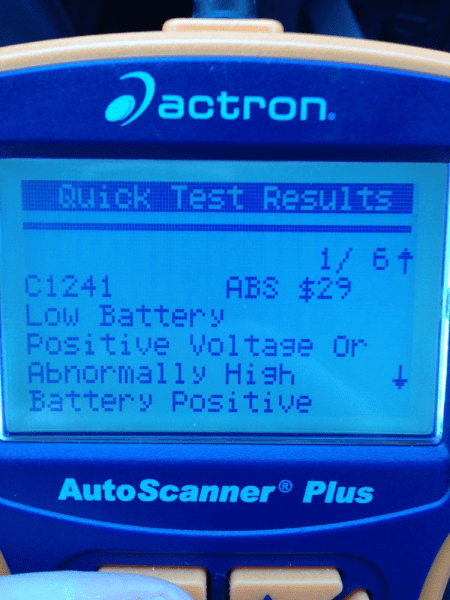Do you have trouble starting your engine, and check engine light is illuminated on the dashboard? It can be due to the P1133 code. You can also notice dark smoke from the exhaust or decreased fuel economy.
P1133 is one of the manufacturer-specific codes that may not appear in all vehicles. PCM sets it when there is a problem with HO2S (Heated Oxygen Sensor) Insufficient Switching Bank 1 Sensor 1. The result is reduced engine performance and other symptoms.
Read on for detailed information about the P1133 code in Toyota, including its causes, symptoms, diagnosis, and fixing.
What Does P1133 in Toyota Mean?
The definition of the P1133 code is HO2S (Heated Oxygen Sensor) Insufficient Switching Sensor 1. It is a manufacturer-specific code set in some vehicle models such as Toyota, Buick, Chevrolet, Isuzu, GMC, and many others.
This code is set by PCM (Powertrain Control Module) to detect a fault with the front HO2S. PCM is the electronic unit that monitors all processes and functions of an engine.

In this case, it checks the performance of HO2S-1 and determines how fast it switches from Lean/Rich (L/R) and Rich/Lean R/L conditions. If the data obtained indicate that HO2S does not switch as it should for a proper air-fuel ratio, it triggers the P1133 code.
The output voltage from HO2S varies depending on the air-fuel ratio. This information goes to the ECM (Engine Control Module), which determines if the air-fuel mixture is rich or lean and adjusts it accordingly for the best engine performance.
Related content: C1241 Code Toyota – Low Battery Positive Voltage (Explained)
Symptoms of P1133 Code
The code P1133 in Toyota manifests itself in many ways, but the most common symptoms include the following:
- Check engine light comes on
- Rough idling
- Problem starting the engine – hard starts
- Reduced fuel economy – increased fuel consumption
- Black smoke coming from the exhaust
Possible Causes of Code P1133 Toyota
Many possible causes of code P1133 in Toyota exist and vary from model to model. They include, but are not limited to, the following:
- Disconnected, corroded, shorted, or damaged connector or wiring harness
- Faulty oxygen sensor
- Exhaust leaks/ Leak in the vacuum system
- Stuck open exhaust gas recirculation (EGR) valve
- Defective PCM
- Defective MAF sensor
- Faulty sensor 1 of bank 1
- Open or shorted harness in bank 1 of HO2S
Related content: P1683 Code – Meaning, Causes, and Solution
How to Diagnose Code P1133
The diagnosis process involves checking all the above causes for faults. Some are easily visible to the naked eye. Others, however, require expertise to know whether some components are defective or not.
But before you diagnose code P1133, ensure no other engine trouble codes are stored in the memory. If there is, resolve them first in the order in which they were stored.
Before conducting a diagnosis, ensure you don’t have any false triggers. Gasket sealers with silicone compounds used in old engines can fault the upstream oxygen sensor. So, check and remove any suspected or confirmed sealants to avoid future reoccurrences.
Lastly, refer to your car manual for any application you intend to work on. For example, the typical voltage output from upstream oxygen sensors ranges from 0.1 volts to 0.9 volts. These values, however, can vary from one Toyota model to another.
Related content: P1604 Code Toyota – Startability Malfunction (Explained)
Code P1133 Diagnosis Steps
- Start the engine and give it time to allow PCM to enter into a closed-loop operation. That is the time it starts receiving a signal from upstream oxygen sensors to control short-term fuel trim adjustments.
- Use a capable OBD2 scanner to open and close throttle valves several times within short intervals to change the oxygen content in the exhaust streams. The OBD2 scanner will indicate maximum and minimum voltage outputs from oxygen sensors. Note them down for future reference. You can skip this step if you don’t have a scanner, but you will work blindly.
- If the OBD scanner confirms oxygen sensors do not switch fast enough, their circuitry has a problem. You should follow it with a visual inspection of all associated wiring and connectors. But before that, refer to your car manual to know its location, routing, color coding, and functions.
- Check the wires and connectors for physical damage, shorts, corrosion, or disconnection. Repair any identified damaged component and clear the error code. Once again, start the engine and monitor the behavior of the sensor in real-time using an OBD2 scanner.
- If the previous step did not show any results, consider performing a ground, resistance, reference voltage, and continuity test. Disconnect the faulty oxygen sensor from the PCM to avoid damaging it. Once again, refer to the manual to identify the heater control circuit wires of the affected sensor. Measure its resistance and that of the signal wire from the sensor and compare it with the manufacturer’s recommendations. Make repairs as appropriate to conform with the specifications.
- Test the internal resistance of all suspected oxygen sensors and replace all that do not match the manufacturer’s specifications.
After all repairs and component replacements, clear the code and test the vehicle in a closed-loop operation. If the code returns, it is due to an intermittent fault, which can be challenging to diagnose. It may take time to finally find it.
Note that clearing other codes before diagnosing P1133 helps to identify other possible causes mentioned. Stuck open EGR valve and vacuum leaks should be fixed before attempting the diagnosis described above.
Related content: How To Deal With ICS Malfunction On Toyota
How to Fix Code P1133
Code P1133 does not necessitate an emergency, but you should fix it as soon as possible. It can lead to engine performance deterioration and other costlier damages.
In most cases, repairing the P1133 code involves repairing vacuum leaks, faulty electrical connections in HO2S bank one sensor 1, and replacing the defective sensors. A thorough diagnosis helps to pinpoint the problem for fixing.
The repair cost of the P1133 code varies depending on the component to be repaired or replaced. However, the primary determinant is the labor cost. Most auto mechanics charge $80-$160 per hour. That may be different from the service fee in your area.
Final Remarks
Code P1133 is HO2S Insufficient Switching Bank 1 Sensor 1. It is set by PCM if the front HO2S does not switch fast enough to correspond to the lean or rich air-fuel mixture conditions.
The most common symptoms include an illuminated check engine oil, rough idle, decreased mileage per gallon, dark smoke from the exhaust, etc. Diagnose and fix this code as soon as possible to avoid further engine performance deterioration.
My name is Jeffrey Williams and I have been a car mechanic for over 35 years. I am currently working NYC Auto Repair Shop, in New York City and recently developed a strong passion about blogging. I decided to put together this blog where I will try and answer the most commonly asked questions I get on a daily basis from my customers.









